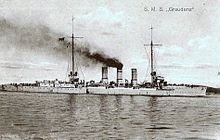Small cruiser
From the end of the 19th century, the term “ Kleiner Kreuzer ” referred to a type of ship in the German Imperial Navy and the Austro-Hungarian Navy . In the latter it was also referred to as a rapid cruiser . In the Imperial Navy, the designation was introduced in 1899 as the official classification for cruisers with a water displacement below 5500 tons .
Small cruisers were used as scouts for the fleet, guide ships for torpedo boat destroyers , as foreign cruisers and also in the trade war.
development
When the classification of small cruisers was introduced in the Imperial Navy, it included completely different earlier types:
- The Avisos , which were designed as reconnaissance aircraft and escort ships for the battle fleet.
- The completely outdated cruisers III. Class of the Alexandrine class , which had been designed as unarmored smooth-deck corvettes in 1875 .
- The unprotected cruisers IV class ( Schwalbe class , Bussard class ) built for foreign service .
- The protected cruiser III. Class and the Irene class belonging to the second class cruisers (the other second class cruisers fell under the large cruisers from 1899 ), which represented draft compromises that should be suitable for both naval and international service.
The small cruisers of the Gazelle class launched from 1898 onwards were the prototype of the small cruiser built up until World War I. The German cruisers should have sufficient armament and speed for service with the fleet as well as comfort and sea endurance suitable for foreign service exhibit. This was in contrast to the British Navy's design practice of building different types of ships for different tasks.
The ships built from the Gazelle class were protected cruisers. The water displacement increased from initially 2650 tons to 5620 tons in 1916. The first classes were driven by triple expansion engines. In terms of protection, this had the disadvantage that the armored deck had to be raised above the piston engines due to their overall height. The greater danger resulting from this "armored bell" was attempted by strengthening the embankments in the elevated area (initially 60 mm, later 100 mm). Only with the general introduction of the turbine drive was it possible to dispense with this weak point and install a smooth armored deck.
As the first small cruisers, SMS Lübeck in 1903 and SMS Stettin in 1905 received the turbine drive, which was generally introduced with the Kolberg class in 1908. This increased the speed from a good 20 knots to 27 knots.
From the Magdeburg class (1911) onwards, the small cruisers received 60 mm thick waterline armor made of soft nickel steel, which ranged from 1.4 m below to 2 m above the construction waterline and over most of the length of the ship. At the same time as this improved protection, the longitudinal band construction was introduced as a replacement for the usual transverse frame construction, whereby a higher longitudinal strength was achieved.
Outwardly, the ships up to the Kolberg class were characterized by a long forecastle with the crew quarters and a hut for the officers' living quarters. Between the forecastle and the hut was a middle deck with a solid bulwark over its entire length. This design was abandoned with the Magdeburg class , as a low entrenchment was needed to enable the cruisers to lay mines (up to Wiesbaden class 120, later 200 mines ).
Up to the Königsberg class, the armament consisted of ten, later twelve, rapid-loading cannons with a caliber of 10.5 cm. With the Pillau class , the 15 cm gun was introduced in 1914, which was also retrofitted on some older ships.
As a specialized sub-type, the mine cruisers of the Brummer class were piled up in 1915 .
From 1922 the small cruisers were designated as light cruisers after the Washington Fleet Conference .
commitment
During the First World War, the ships were mainly used in outpost service (e.g. in the First Battle of Heligoland ) or with the fleet (e.g. in the Skagerrak battle ). It is known to be used as a commercial sturgeon cruiser ( SMS Emden , Karlsruhe , Königsberg ), although the ships were less suitable for this due to their low sea endurance. Cut off from home by the outbreak of war on a station abroad, the ships were forced into this role. In the beginning they operated successfully, but were quickly captured and destroyed by the superior British Navy.
Classes of small cruisers of the Imperial Navy
- Gazelle class
- Bremen class
- 1st Königsberg class
- Dresden class
- Kolberg class
- Magdeburg class
- Karlsruhe class
- Pillau class
- Graudenz class
- Wiesbaden class
- Brummer class
- 2nd Königsberg class
- Cologne class
See also
literature
- Bruno Weyer (Ed.): Taschenbuch der Kriegsflotten 1922. JF Lehmann-Verlag, Munich, new edition 1922.
- Hans H. Hildebrand, Albert Röhr, Hans-Otto Steinmetz: The German warships. 6 volumes. Koehlers Verlagsgesellschaft, Hamburg 1983–1993.
- Mike J. Whitley: Cruiser in World War II. Motorbuch Verlag, Stuttgart 1997, ISBN 3-613-01842-X .

